Experience how Change to Chill activities can help teens stress less.
Lead a youth workshop.
Use the lessons and instructions that follow to lead a one-time workshop for young people that will help them be healthier, happier and more resilient. The materials can work in almost any setting where youth gather.
There is so much pressure on teens and pre-teens to do and be their best in school, at home, online, in after-school activities and socially…just about everywhere. Yet many of the things people do to try to be their best actually work against them. Stress, it turns out, is a BARRIER to almost everything. Change to Chill is all about learning how to reduce the mental health stigma and establish healthy ways to deal with stress. It’s a resource teens can turn to anywhere and anytime they have Internet access.
Simply follow the steps below to lead your group through a stress management workshop, starting with “Introduction.”
Introduction
Show the Change to Chill intro video. Take a few minutes to see if anyone in the group has a reaction, comment or question they’d like to share about the video or about stress in general. Don’t spend too much time on this, but do give people a chance to speak. Then explain that in today’s session they will learn about some of the many resources available through Change to Chill and have a chance to practice using some of them.
Create a Safe Space
Point out that talking about stress, what causes it and ways to deal with it might mean that at some point you’ll address sensitive or emotional topics. It’s important therefore to create a safe space where people feel they can share information and ideas and be respected and treated well. Ask the group to brainstorm a list of expectations, norms or agreements that will help make that so. If necessary offer a few examples to get them started. Write their ideas on a piece of poster board or flip chart paper and then post it where everyone can see it. You can point back to it during the session as a reminder if and when they need it.
If during the discussion young people don’t mention the following ideas consider adding them:
Confidentiality—What’s said in the room stays in the room.
Non-judgment: The causes of stress and ways of dealing with it are different for everyone. This group is about learning to recognize and manage your own stress, not “fix” others. Refrain from counseling, coaching, or critiquing what others say or do in the group.
Listen to hear, not respond: Again, each person is unique. When others are sharing their stories, thoughts or ideas, listen and try to understand, ask clarifying questions, affirm what’s being said, but don’t try to argue points, persuade others, or correct things you think are wrong.
Respect self, others, and the space: Be good citizens of the group. If you choose to not participate make sure you are not distracting or otherwise making it difficult for your peers to participate in the ways they choose.
Determine Stress Factors
Have teens take the stress factors quiz. They can do this together if they prefer and agree to choose the answers they think are most common among their group or among teens in general. There are five questions and no right or wrong answers. By taking the quiz teens will learn where their own stress is coming from and what stress does to them.
Once participants have answered the 5th and final question and clicked “next,” a results page will appear. Give time for reviewing the customized results and exploring the recommended resources on the website. This can be done individually or in a group setting. Never pressure individuals to share their answers or results if they don’t want to.
What Is Stress?
Visit the What Is Stress? page. Once there read through as a group the Causes of Stress section. Distribute copies of the Stress: What Brings It On? worksheet. Alternately, have them view the worksheet to see how it’s set up. Then ask them to each draw three matching columns on a blank piece of paper, marking the top of the columns (from left to right) “then,” “now” and “when.” Follow the instructions on the worksheet.
Five-Minute Meditation
Meditation is one of the healthiest and most effective stress-busting strategies. It is the practice of turning your attention to a single point of focus. It can take many different forms.
Change to Chill has a number of options for trying meditation with the help of videos and guided audio recordings. Learning some easy relaxation and meditation techniques can help you think more clearly, make better decisions, and manage whatever comes your way.
Invite participants to each get in a comfortable position. Inform them they can either watch the full video quietly or close their eyes. Either way, encourage them to follow the instructions and try the meditation. If necessary, remind them of the Safe Space agreements. At the end of the meditation take a few minutes to discuss what they thought of the experience. Point out that they can come back to the Change to Chill website and experience this or other guided meditations and relaxation activities at any time.
Mindful Movement for Any Room
Introduce the idea of mindful movement or simply stretching and breathing as a way to reduce stress. Do these slowly and at ease taking at least five full breaths during each pose or timing each for one minute.
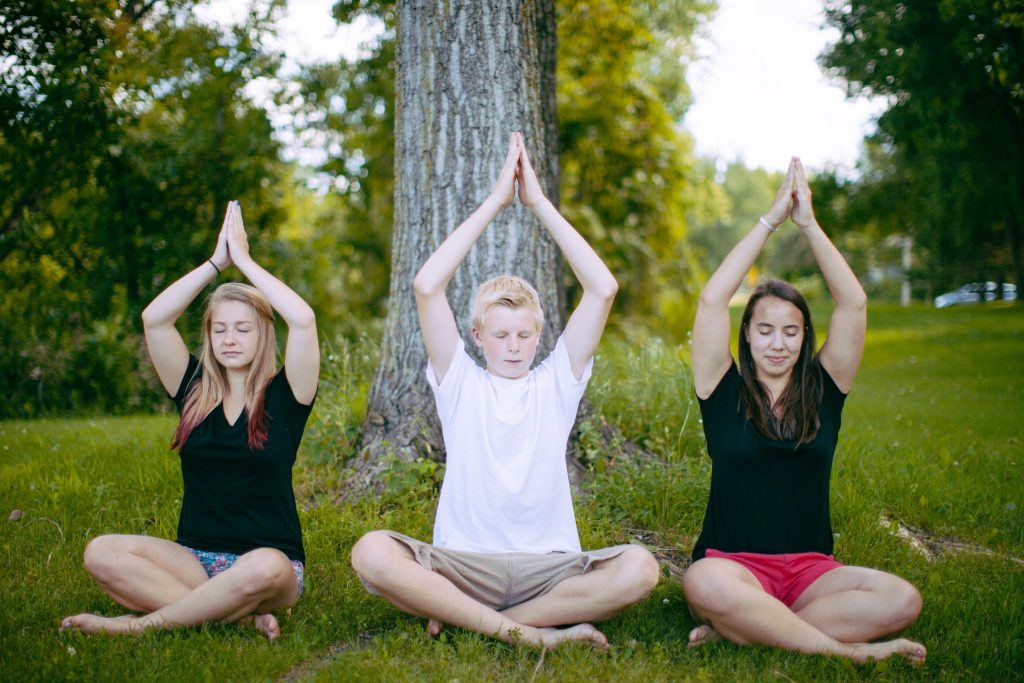
Sun Breath
Sit on the floor with your legs crossed, or in your chair with feet flat on the floor, and your back straight. Put the palms of your hands together at the center of your chest. Close your eyes and begin by taking three big sun breaths.
Here’s how: When you breathe in deeply, raise your arms above your head in the shape of a big round sun. Then breathe out and bring your arms back down so that your palms are together at the center of your chest.
Do this at least three times. The sun breath allows you to become centered and focused on your breath.
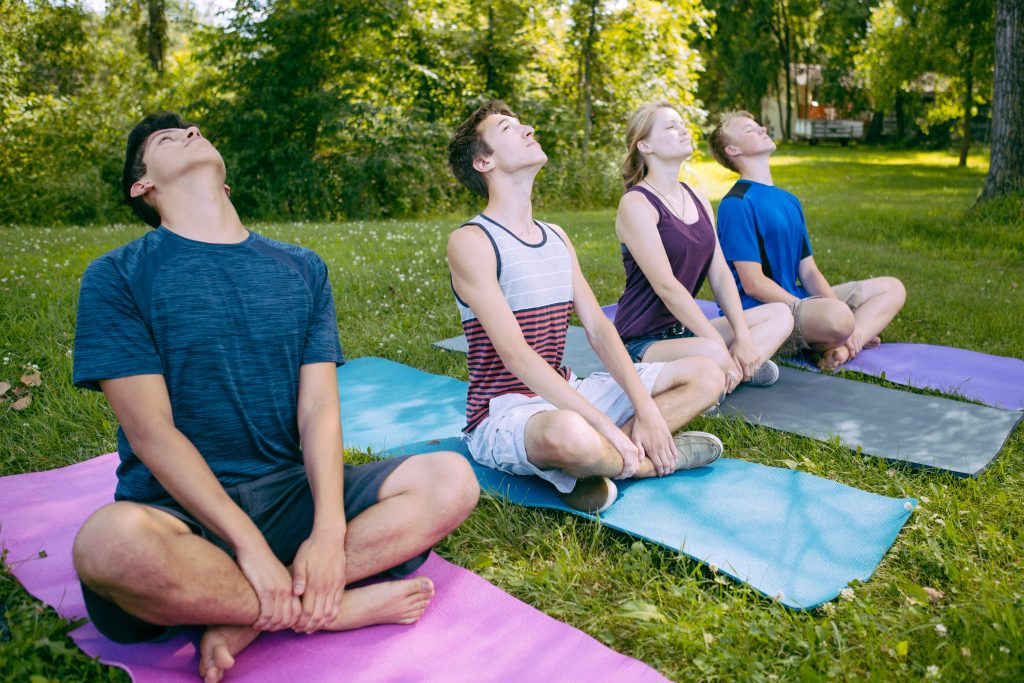
Space Float
Sit on the floor with your legs crossed or in a chair with feet flat on the floor. Take hold of your outside ankle. If you are sitting on a chair, hold onto the edges of the chair by the outside of your legs, above the knees.
Breathe in deeply as you stretch your body forward, chest and stomach out. Breathe out as you slump back, spine is curved, chest is caved in. Keep moving this way and get faster and faster.
Space float gives you a flexible spine. It keeps your back muscles relaxed and strong. It also helps you digest your food.
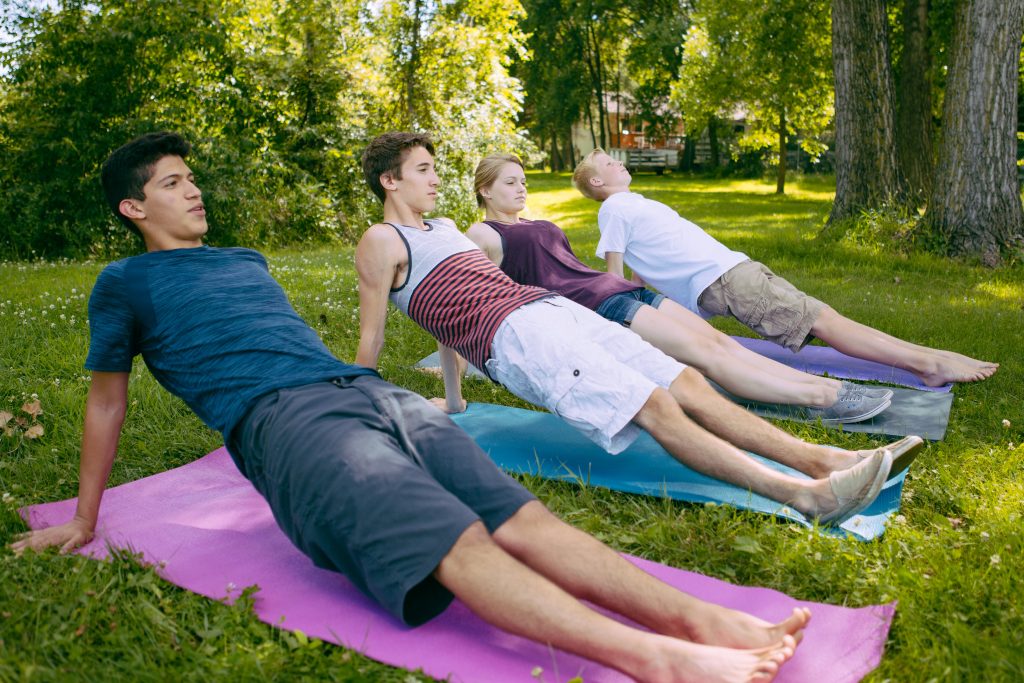
Reverse Plank
Sit on the floor with your feet in front of you and your hands behind you on the floor. Breathe in and push yourself up into a kind of backwards push-up.
Make yourself into a perfectly straight line, like a shooting star, by pushing your stomach up and pointing your toes away from you.
Hold this pose for a count of 10, 20 or 30. Can you go for 50?
Reverse Plank makes your arms, legs and stomach muscles strong. You can also do this pose while sitting in a chair. Hold the edges of the chair and push up like the description above.
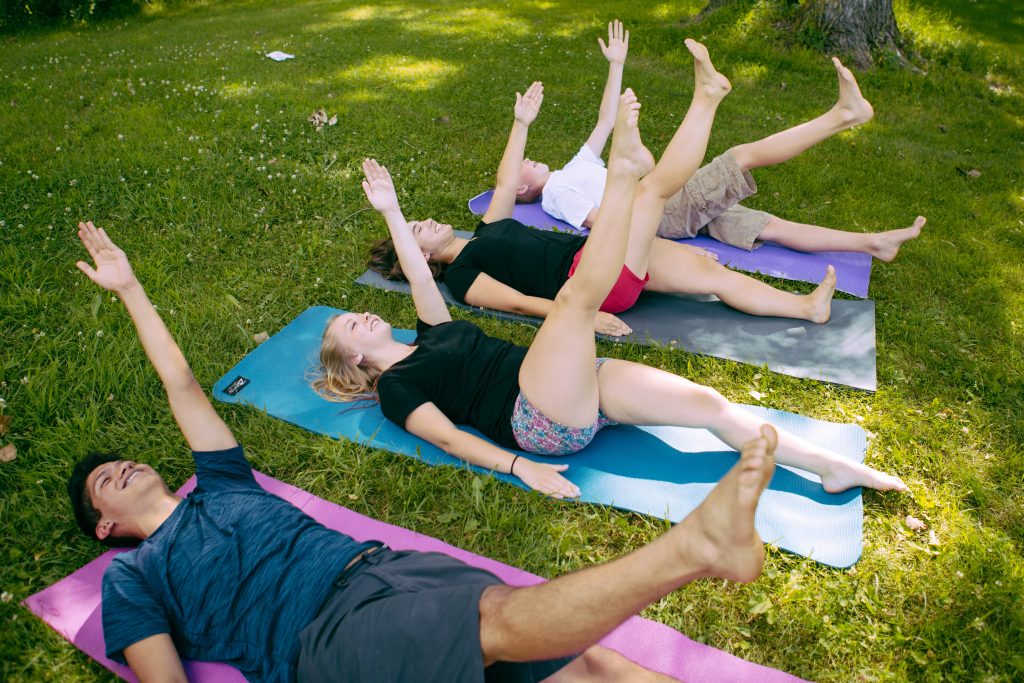
Moon Walk
Sit in your chair or lie down on the floor on your back.
Begin to walk in the air. Keep your right leg straight and lift it up as you lift your left arm. Breathe in as you lift. Breathe out as your arm and leg go down.
Then breathe in again and lift your left leg and right arm together.
Breathe out as your arm and leg go down.
Keep going. Lift your leg and stretch your arm straight up toward the sky. Moon Walk balances the two sides of your brain and helps you think better.
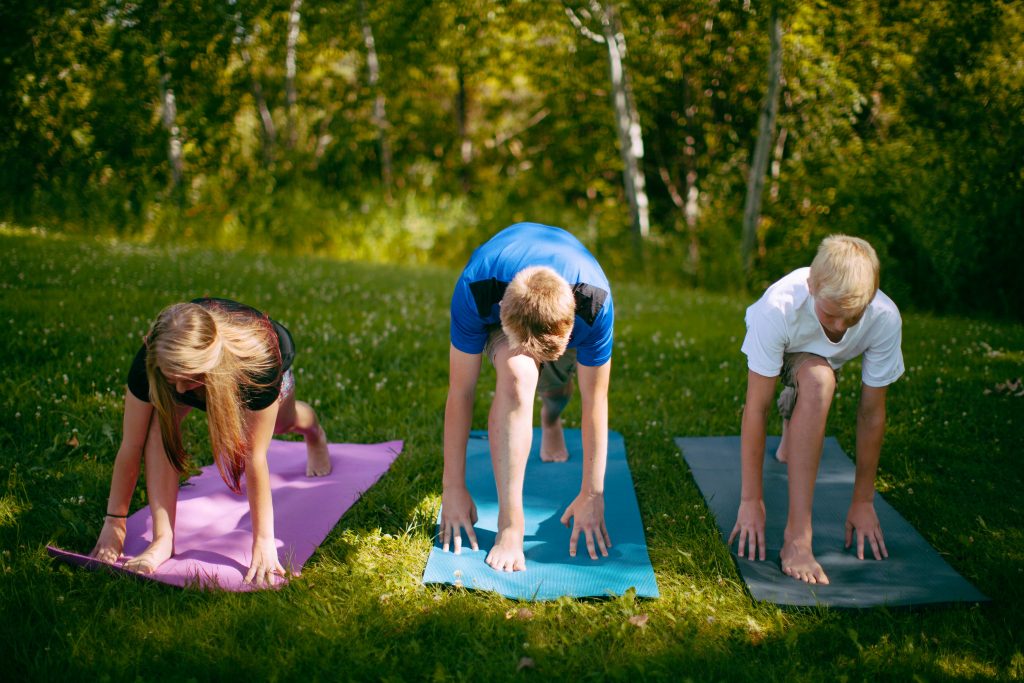
Deep Lunge
From standing, step left foot back as far as comfortable, staying high on the fall of the left foot, keeping the right knee over the right ankle bring right knee to 90 degrees if you can, keep left leg strong and straight. Pull abdominals in and as you breathe in move straight arms from sides up to sky and meet them in the middle above your head, hold for a moment, then as you exhale move straight arms down to side, repeat 5 more times, then switch legs.
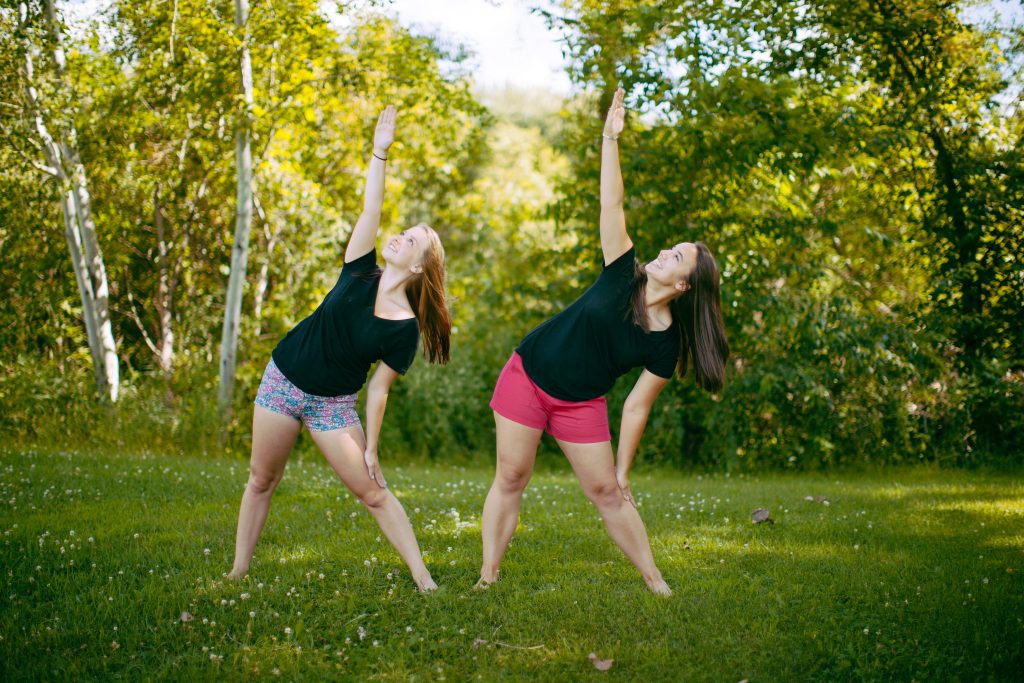
Up Triangle
From standing, feet facing forward, spread feet apart as you are able. Bring straight arms above your head, palms together and look up at hands, tuck tailbone in, abdominals tight and focus on strong body, activating all your muscles in body to hold this pose. Breathe for 5 deep breaths in and out.
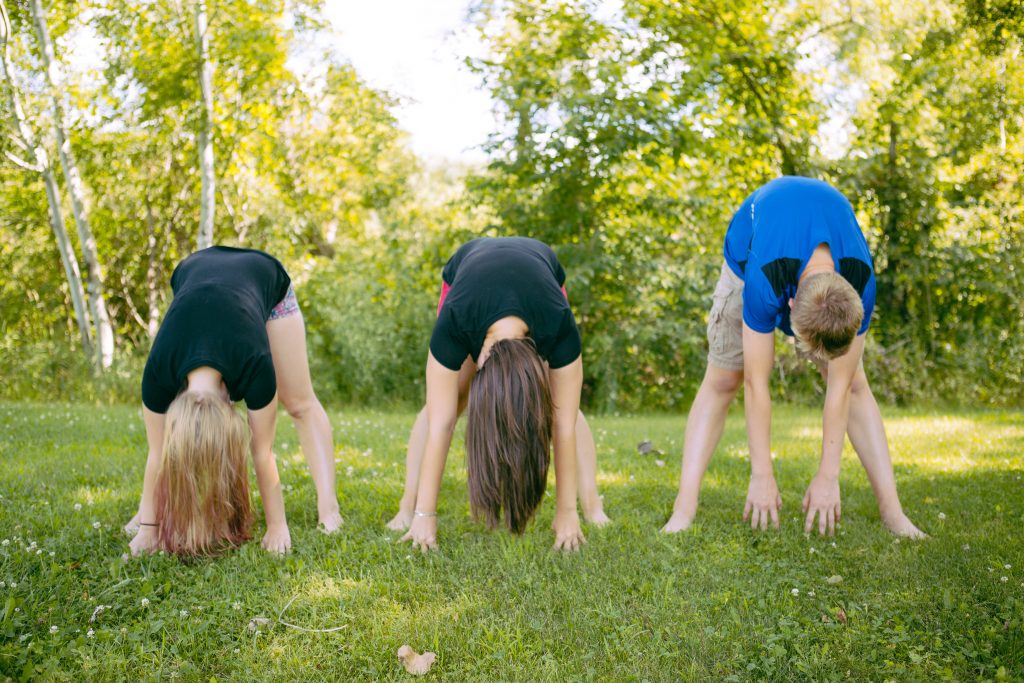
Down Triangle
From standing, feet facing forward, spread feet apart as you are able. Slowly bend at the hips forward bring your head and elbows as close to the floor as possible, breathe deeply and fully as you relax for 5 breaths.
Mindful Eating
Distribute one individually wrapped candy or other food item to each participant. Ask them to wait until instructed to unwrap the candy and begin. Then lead them through the step-by-step directions. End with a discussion using the following questions as a guide:
- What did you notice during that experience?
- What did you like most? dislike most?
- How can you incorporate mindful eating into meals and snacks? Would that change your experience with food?
Take the Chiller Challenge
Chillers are quick, helpful messages about how to slow down and step back from stress. The Chiller Challenge is a creative outlet for self-expression and individuality. Show participants the short video so they know what it’s all about. Then see the “Chiller Challenge for Teens” guidelines and examples. Finally, give young people some time to work on creating their own Chillers either for themselves or to submit to Change to Chill.
What’s Next?
Point out that changing to chill is what’s known as a practice. It’s something you do regularly and learn about over time. No one ever just learns to chill once and then is done. Fortunately the Change to Chill resources are available any time and anywhere young people have Internet access. To encourage teens to continue the practice they’ve started today, ask them choose one activity or suggestion from the website that they are committed to trying or repeating in the next week. Invite volunteers to say which thing they are going to try and why.


 Pinterest
Pinterest  Instagram
Instagram 

